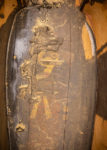 A painting of the Egyptian sun god Ra has been found inside the coffin of 22nd Dynasty (945‒712 B.C.) priest Ankh-khonsu now at the Harvard Semitic Museum. When conservators opened the lid, they saw the image of the falcon-headed god, partially obscured by blackened resin that was poured over the coffin during the funerary rights, on the interior bottom of the case.
A painting of the Egyptian sun god Ra has been found inside the coffin of 22nd Dynasty (945‒712 B.C.) priest Ankh-khonsu now at the Harvard Semitic Museum. When conservators opened the lid, they saw the image of the falcon-headed god, partially obscured by blackened resin that was poured over the coffin during the funerary rights, on the interior bottom of the case.
The coffin has been in the museum’s collection for 118 years, so you’d think its contents wouldn’t come as a surprise, but the mummy it once held was removed when it arrived at the museum and the closed coffin has been display most of the time since. It was opened again 30 years ago, but its interior was either not documented or the records were lost.
There was no risk of that happening this time. The coffin was opened in order to digitize it, part of a program to record every detail of the object and create a digital model that will allow museum visitors, the interested public and researchers around the world full access to Ankh-khonsu’s coffin without interfering with its display or conservation environment.
Despite the uneven texture of the area and the dark coating, Manuelian and his colleagues could see the yellow, orange, and blue painting and the hieroglyphs that read “Ra-Horakhty, the great God, Lord of Heaven” next to the figure.
As part of the project, Manuelian assembled an “all-star cast” of conservators, a professional photographer, and pigment sampling and residue and wood analysis experts to collect information and capture imagery of the coffin materials and adornments. Colleagues came from as far away as University College London and from just down the street at the Harvard Art Museums.
From the hieroglyphics on the coffin we know Ankh-khonsu was a doorkeeper in the Temple of Amun-Ra at Karnak in ancient Thebes (modern-day Luxor). It was a position he inherited from his father Ankh-en-amun. Two other 22nd Dynasty coffins in the museum, a painted wood one belonging to Mut-iy-iy and a cartonnage one belonging to Pa-di-mut, were also opened, documented and scanned, but their records were more complete so no surprises were found.
Great flukes of history tangent!
The coffin was given to the museum by Theodore M. Davis (1838-1915), a wealthy lawyer, businessman and avid Egyptophile who spent the last 15 years of his life spending winters in Egypt and sponsoring excavations. The digs he funded in the Valley of the Kings unearthed 30 tombs: KV20, the original tomb of Thutmose I, KV43, tomb of Pharaoh Thutmose IV, and KV55, aka the Amarna cache, containing the remains of Pharaoh Akhenaten, among other notable finds.
The first three seasons of Davis’ excavations were conducted by Howard Carter, then the inspector-general of antiquities for Upper Egypt. Despite the many important discoveries his teams had made, Davis wanted more than anything to find an intact royal tomb and he came to believe that the Valley of the Kings, thoroughly plundered and recycled as its tombs had been over the millennia, was “exhausted” of any such treasure. He gave up the exclusive concession to excavate the Valley of the Kings in 1914. Who got it next, you ask? Why, that would be Lord Carnarvon. The rest, as they say, is history. Davis died in 1915 so he never saw his successor and his former dig leader hit the dirtiest of all paydirt when they discovered the untouched tomb of Tutankhamun in 1922 six feet away from where Davis’ last excavation had stopped.